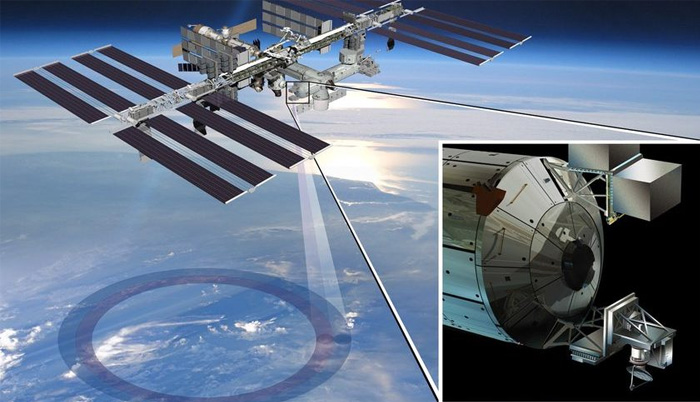![]() Home > Space & Science
Home > Space & Science
RIP, RapidScat: NASA Ends Repair Work on Space Station Earth Science Tool

An illustration of the RapidScat instrument in operation on the ISS. Credit: NASA/JPL-Caltech/Johnson Space Center
![]() November 30th, 2016 | 10:08 AM |
November 30th, 2016 | 10:08 AM | ![]() 1388 views
1388 views
WASHINGTON
NASA announced Nov. 28 it was formally ending a mission of an instrument on the International Space Station that malfunctioned earlier this year, a setback in the agency's efforts to use the station as an Earth sciences platform.
NASA said it was terminating the ISS Rapid Scatterometer, or RapidScat, instrument, that had been operating on the station since October 2014. The instrument collected wind speed and direction data over the oceans by measuring the scattering of radar waves it transmitted and then received.
RapidScat lost power Aug. 19 when an electrical power distribution system in the station's Columbus module malfunctioned. As space station controllers worked to restore power to RapidScat and several other affected instruments later that day, an electrical outlet overloaded. While controllers were able to restore power to the other instruments, they were unable to power up RapidScat again, making the last attempt to do so Oct. 17.
Even before the loss of power, RapidScat had encountered problems. The instrument suffered an anomaly in August 2015 that caused a significant drop in the power level of the reflected signal. Several times since the initial anomaly the instrument's gain would briefly increase to normal levels before dropping again, complicating efforts by scientists to use the data to monitor ocean winds.
NASA considered RapidScat an experiment not just in collecting ocean wind data but in the use of the ISS as a platform for Earth science observations. While the station's orbit is not considered ideal to many scientists who often prefer instruments in sun-synchronous orbits, the infrastructure the station provides for instruments, including power and data, has made it attractive as a less expensive option than a dedicated spacecraft.
"As a first-of-its-kind mission, ISS-RapidScat proved successful in providing researchers and forecasters with a low-cost eye on winds over remote areas of Earth's oceans," Michael Freilich, director of NASA's Earth science division, said in a statement announcing the end of the mission.
RapidScat was developed as a gapfiller to collect ocean wind data after the QuikScat spacecraft suffered a mission-ending malfunction in 2009. It used spare parts left over from QuikScat, allowing it to be built and launched in two years. It flew to the ISS on a SpaceX Dragoncargo mission in September 2014 for what was planned to be a two-year primary mission.
NASA has no plans to replace RapidScat with another instrument on the ISS or other spacecraft. Instead, the agency said it will use data from ScatSat-1, an Indian spacecraft launched in September that has a similar scatterometer instrument.
Since then, NASA has installed another Earth science payload, the Cloud-Aerosol Transport System sensor, on the ISS, in 2015. The Stratospheric Aerosol Gas Experiment 3 (SAGE-3) experiment, designed to measure ozone levels in the atmosphere, is scheduled for launch in early 2017 on a Dragon resupply mission. A lightning image sensor is also scheduled to be installed on the station in 2017.
Source:
courtesy of SPACE
by Jeff Foust
If you have any stories or news that you would like to share with the global online community, please feel free to share it with us by contacting us directly at [email protected]